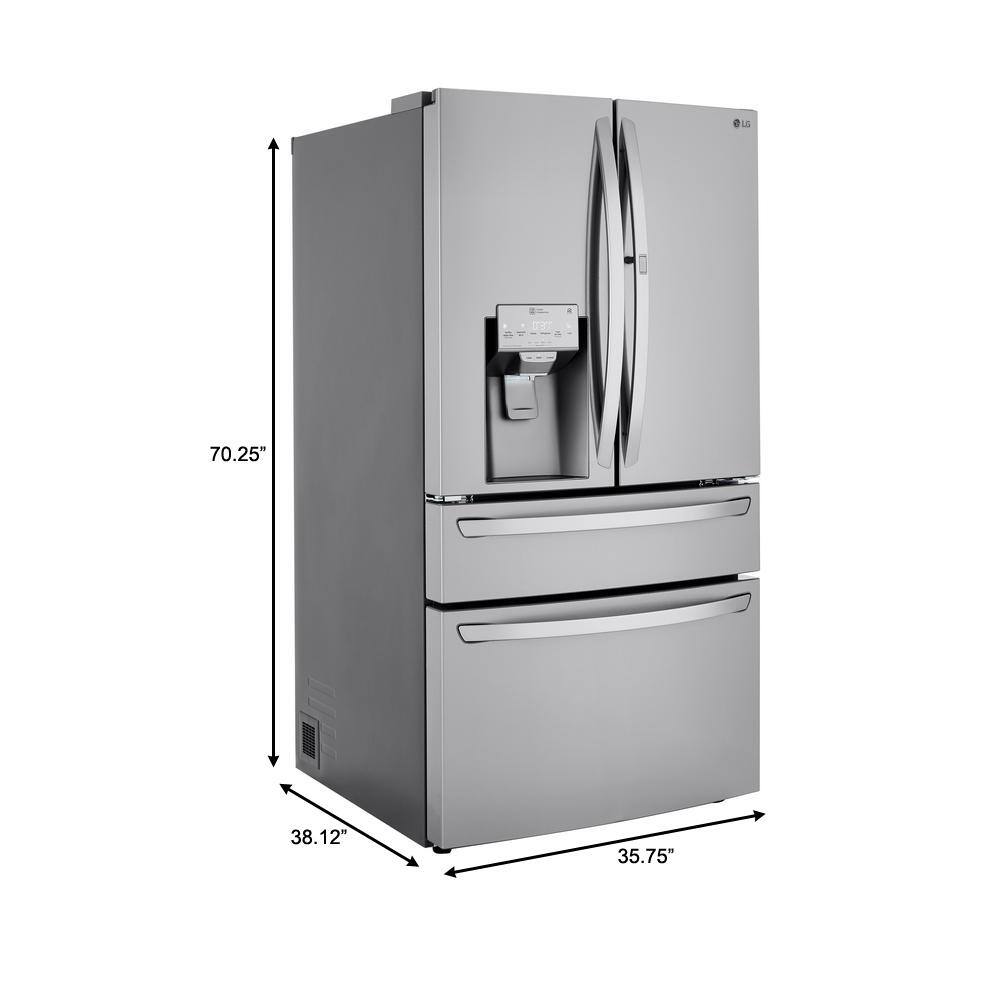LG 25.50 cu. ft. Bottom Freezer Refrigerator in PrintProof Stainless Steel with Filtered Ice
26 cu. ft. of space lets you store your favorite foods. The Door Cooling + air duct keeps door contents at peak freshness. Smart Cooling system monitors conditions to keep food fresh.
A generous 26 cu. ft. of space gives you ample room for your needs. With contoured doors, hidden hinges, and a host of great interior features like Door Cooling+ and LED lighting give your refrigerator a look as sophisticated as it is functional.
- Stock-up and store everything you need. With a cavernous 26 cu. ft. of space, this LG Bottom Mount refrigerator gives you ample space for all of your family’s favorite foods and keeps them conveniently organized within reach
- Now you can have all of the things you love about stainless, without the need for special cleaners or constant attention. LG’s PrintProof fingerprint and smudge resistant finish easily wipes clean with a soft, dry cloth for a distinctive kitchen that handles real-life in style
- Multi-Air Flow System is designed to maintain superior humidity and temperature levels to help keep your food fresher, longer. Digital sensors constantly monitor conditions within the refrigerator and strategically-placed vents in every section to help surround your food with cool air no matter where you put it
- Consistent temperatures are the key to food freshness. LG took its advanced freshness system one step further by adding Door Cooling+ to provide a steady supply of cold air to help keep door contents at peak freshness
- Smart Cooling system is designed to maintain superior conditions within the refrigerator
- LED lighting recessed on top provide an exceptionally bright interior and saves energy over traditional lighting
- SmartDiagnosis helps the service center diagnose problems over the phone, helping you troubleshoot quickly
- ENERGY STAR qualified LG refrigerator exceeds federal energy standards to positively impact your energy bill, your energy consumption, and most importantly, the environment
- Humidity-controlled crispers help maintain humidity levels to help extend the life of your fruits and vegetables
- Elegant clean lines, contoured doors, hidden hinges, and a host of great interior features give your refrigerator a look as sophisticated as it is functional
- Linear Compressor reacts quickly to temperature fluctuations and helps keep your food fresher, longer. Meanwhile, strategically-placed vents in every section help to surround your food with cool air no matter where you put it
Additional information
| Depth (Excluding Handles) | 33 |
|---|---|
| Depth (Including Handles) | 34.88 |
| Depth (Less Door) | 29 |
| Depth With Door Open 90 Degrees (In) | 62.75 |
| Height to Top of Door Hinge (in.) | 69.88 |
| Height to Top of Refrigerator (in.) | 68.63 |
| Product Depth x Height x Width (in.) | 34.88 x 69.88 x 32.75 |
| Refrigerator Width (In.) | 32.75 |
| Certifications and Listings | Energy Star |
| Manufacturer Warranty | 1 Year Parts & Labor, 5 Years Sealed System (Parts & Labor), 5 Years Compressor (Parts & Labor), 6-10 Years Inverter Compressor (Parts Only) |






by Lily
This is a great refrigerator, it is a nice size, the ice maker is Awesome (I have been without one for several years). I like the stainless steel, the only reason I gave it 4 stars is because it is listed as not showing fingerprints and it does! Otherwise I’m very happy with my purchase.
by Hoully
Very stylish And functionality is extraordinary. The large capacity of cool that he still in the top and the bottom is a plus plus plus. But this Product gets zero stars when it comes to service.
by Earl
Great fridge! Only set back is the drawers bump each other when closing but still an awesome product.
by Brian
Great fridge – and price comparatively low to similar models of other brands.
by Brad
What a great fridge. Love the size and easy to use. The extra hinges to reverse door swing was a great bonus and easy to switch out. Ice maker works great and doesn’t smell weird. Highly recommended.
by Carol
So far so good! Lots of room and good temp! Love the bottom freezer.